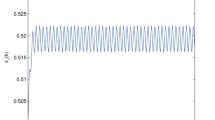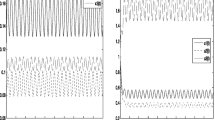Summary
The classical Volterra equations modelling three species predatorprey interactions are considered with the intention of developing global properties of their solutions. Thirty-four different cases are exhibited. Global asymptotic stability is established for all non-loop cases. Global boundedness is established for all but one kind of loop case, and a condition is exhibited which insures boundedness for that case also. Finally a particular case is shown to have unbounded solutions.
Similar content being viewed by others
References
Andronov, A. A., Leontovich, E. A., Gordon, I. I., Maier, A. G.: Qualitative theory of second order dynamical systems, New York, J. Wiley, 1973
Barbashin, E.: Introduction to the theory of stability, Groningen: Wolters-Nordhoff 1970
Barker, G. P., Berman, A., Plemmons, R. J.: Positive diagonal solutions to the Lyapunov equations, Linear and Multilinear Algebra (to appear)
Freedman, H. I., Waltman, P., Mathematical analysis of some three species food chain models, Math. Biosci. 33, 257–276 (1977).
Goel, N. S., Maitra, S. C., Montroll, E. W., On the Volterra and other nonlinear models of interacting populations, Rev. Modern Phys., 43, 231–276 (1971)
Goh, B. S., Global stability in two species interactions, J. Math. Biol. 3, 313–318 (1976)
Goh, B. S.: Global stabilities in many-species systems, Am. Nat. 111, 135–143 (1977)
Hausrath, A. R.: Stability properties of a class of differential equations modeling predatorprey relationships, Math. Biosci. 26, 267–281 (1975)
Haussman, U.: Abstract food webs in ecology, Math. Biosci. 11 291–316 (1971)
Hsu, S. B.: The application of the Poincaré transform to the Lotka-Volterra model, J. Math Biol. 6 67–74 (1978)
Kilmer, W. L.: On some realistic constraints in predator-prey mathematics, J. Theor. Biol. 36, 9–22 (1972)
LaSalle, J., Lefschetz, S.: Stability by Liapunov's direct method, New York: Academic Press, 1961
Levins, R.: Qualitative analysis of partially specified systems, Am. N.Y. Acad. Sci. 231, 123–138 (1974)
May, R. M., Leonard, W. L.: Nonlinear aspects of competition between three species, SIAM J. Appl. Math. 29, 243–253 (1975)
McGehee, Armstrong, R. A.: Some mathematical problems concerning the ecological principle of competitive exclusion, J. Differential Equations 23, 30–52 (1977)
Rescigno, A.: The struggle for life-IV two predators sharing a prey, Bull. Math. Biol. 39, 179–185 (1977)
Rescigno, A., Jones, K. G.: The struggle for life: III a predator-prey chain, Bull. Math. Biophys. 34, 521–532 (1972)
Rosenzweig, M. L.: Exploitation in three trophic levels, Amer. Nat. 107, 275–294 (1973)
Volterra, V.: Lecons sur la théorie mathématiques de la lutte pour la vie, Paris: Gauthier-Villars, 1931
Wollkind, D. J.: Exploitation in three trophic levels; an extension allowing intraspecies carnivore interaction, Amer. Nat. 110, 431–447 (1976)
Yorke, J. A. Anderson, W. N. Predator-prey patterns, Proc. Nat. Acad. Sci. USA 70, 2069–2071 (1973)
Gallopin, G. C.: Structural properties of food webs. In: Systems analysis and simulation in ecology (B. C. Patten, ed.) Vol. 2, New York, Academic Press, 1972
Paine, R. T.: Food web complexity and species diversity, Am. Nat. 100 65–75 (1966)
Cohen, J. E.: Food webs and niche space, Princeton Univ. Press, 1978
Whittaker, R. H.: Communities and ecosystems, New York: Macmillan, 1970
Author information
Authors and Affiliations
Rights and permissions
About this article
Cite this article
Krikorian, N. The volterra model for three species predator-prey systems: Boundedness and stability. J. Math. Biology 7, 117–132 (1979). https://doi.org/10.1007/BF00276925
Received:
Issue Date:
DOI: https://doi.org/10.1007/BF00276925




